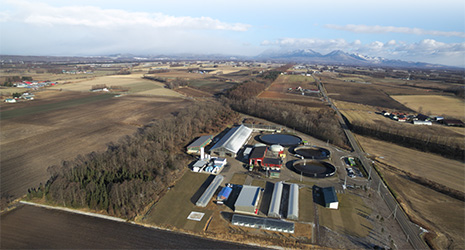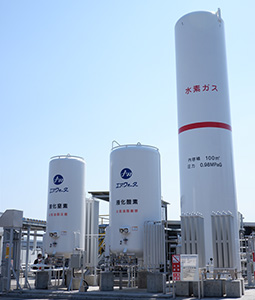Home > Highlighting JAPAN > Highlighting Japan May 2019 > Regional Revitalization
Highlighting JAPAN


A Town Producing Milk and Hydrogen
The livestock farming area Shikaoi Town, Hokkaido is implementing initiatives to improve the local environment, prevent global warming, and revitalize local industries, utilizing a plant that produces biogas from livestock excreta to “create sustainable and vibrant industries.”
Hokkaido is a major hub of beef and dairy farming utilizing wide tracts of land. The large volumes of livestock excreta produced on the farms have resulted in problems such as soil and water pollution, as well as foul-smelling air.
Shikaoi Town, located almost in the middle of Hokkaido, is working to alleviate these problems while harnessing livestock excreta as a resource at the same time. The population of the town is around 5,500, while the number of cows is around 20,000. In 2007, Shikaoi Town constructed the Shikaoi Environmental Preservation Center, and began creating a biomass resource from the excreta of dairy cows. The center ferments excreta collected at local dairy farms in dedicated containers to produce odorless liquid fertilizer and biogas. Because the cow feed used at the dairy farms is plant matter, the biogas made from excreta is a carbon-neutral fuel that does not increase carbon dioxide (CO2) in the atmosphere when burned. The liquid fertilizer is sprayed on the fields and biogas is used to power the generators. As well as being used to operate machinery in facilities, electricity produced by biogas is sold to power companies. In addition, efforts are being made to create new industries such as mango cultivation and sturgeon breeding using water heated by residual heat from power generation. The treatment of excreta at the center not only alleviates soil and water pollution and foul-smelling air, but also helps reduce the time spent and costs incurred by dairy farmers in processing the excreta.
Since 2015, in order to further reduce CO2 emissions and increase the possible uses for biogas, attempts have been made to manufacture hydrogen utilizing the biomass produced at the center. Hydrogen production equipment, hydrogen stations, and other equipment have been newly installed in the Shikaoi Hydrogen Farm established inside the center, and the “Verification project of hydrogen supply chain utilizing hydrogen from livestock excreta” commissioned by Japan’s Ministry of the Environment is being implemented. With the cooperation of Shikaoi Town, the project is being implemented by Air Water Inc., Kajima Corporation, Nippon Steel Pipeline & Engineering Co., Ltd. and Air Products Japan K.K., and is planned to run until FY2021. Shikaoi Hydrogen Farm is the first facility in the country to make hydrogen using livestock excreta, and extremely rare worldwide.
“The project targets to build a hydrogen energy supply chain, from production to transport and use. It aims to promote medium- and long-term measures against global warming by demonstrating the effects of decarbonization of hydrogen production by employing renewable energy — biogas — and practical utilization of hydrogen. We aim to be a model case for the coming hydrogen society by realizing a town which locally produced and consumed hydrogen and which does not emit CO2 when it is used,” says Tomohiro Inoue, Senior Manager of the Engineering Integration Department of Air Water.
At the Shikaoi Hydrogen Farm, hydrogen is generated by the reaction between methane gas extracted from biogas and water vapor, in a hydrogen manufacturing device. The hydrogen is then transferred into racks of cylindrical tanks called curdles. The hydrogen in the curdles is used for fuel cells installed in a fuel cell vehicle, forklift and sturgeon breeding facilities. Curdles are also supplied to dairy farmers in the town and to a tourist facility in the neighboring Obihiro City.
If an efficient hydrogen supply chain can be established, dairy farming in Shikaoi will change dramatically. Each cow produces some 23 tons of excreta per year. With this volume of waste, it is possible to produce enough hydrogen to power a fuel cell car over a distance of around 10,000 km. That is comparable to the average annual mileage of Japanese cars for personal use. Dairy farmers consume an enormous amount of energy for daily tasks such as feeding, water supply, milking, milk preservation, and cleaning, resulting in costly gas and electricity bills. If the energy required for these tasks could be provided by hydrogen derived from livestock excreta, management costs would be reduced, leading to the revitalization of regional dairy farming.
“In view of the large-scale power failure that occurred at the time of the Hokkaido Eastern Iburi Earthquake in September 2018, there are high expectations of hydrogen energy as an emergency power source. Going forward, we would like to tackle the issues of hydrogen transportation methods and cost reduction, working toward the realization of a hydrogen supply chain,” says Tadashi Ohno, senior manager of the Marketing Group, Environmental Engineering Division of Kajima.
In the near future, Shikaoi will be a sustainable and vibrant town famous not only for its milk but also for its hydrogen.
© 2009 Cabinet Office, Government of Japan








